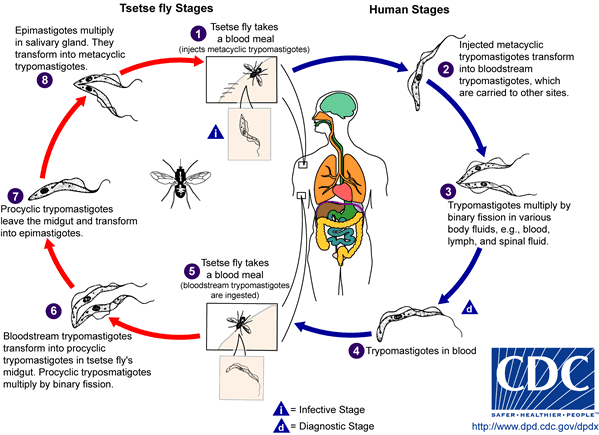| |
During a blood meal on
the mammalian host, an infected tsetse fly (genus Glossina) injects
metacyclic trypomastigotes into skin tissue. The parasites enter the
lymphatic system and pass into the bloodstream
 . Inside
the host, they transform into bloodstream trypomastigotes . Inside
the host, they transform into bloodstream trypomastigotes
 , are
carried to other sites throughout the body, reach other blood fluids (e.g.,
lymph, spinal fluid), and continue the replication by binary fission , are
carried to other sites throughout the body, reach other blood fluids (e.g.,
lymph, spinal fluid), and continue the replication by binary fission
 . The
entire life cycle of African Trypanosomes is represented by extracellular
stages. The tsetse fly becomes infected with bloodstream trypomastigotes
when taking a blood meal on an infected mammalian host ( . The
entire life cycle of African Trypanosomes is represented by extracellular
stages. The tsetse fly becomes infected with bloodstream trypomastigotes
when taking a blood meal on an infected mammalian host ( , ,
 ). In
the fly’s midgut, the parasites transform into procyclic trypomastigotes,
multiply by binary fission ). In
the fly’s midgut, the parasites transform into procyclic trypomastigotes,
multiply by binary fission
 , leave
the midgut, and transform into epimastigotes , leave
the midgut, and transform into epimastigotes
 . The
epimastigotes reach the fly’s salivary glands and continue multiplication by
binary fission . The
epimastigotes reach the fly’s salivary glands and continue multiplication by
binary fission
 . The
cycle in the fly takes approximately 3 weeks. Humans are the main reservoir
for Trypanosoma brucei gambiense, but this species can also be found
in animals. Wild game animals are the main reservoir of T. b.
rhodesiense. . The
cycle in the fly takes approximately 3 weeks. Humans are the main reservoir
for Trypanosoma brucei gambiense, but this species can also be found
in animals. Wild game animals are the main reservoir of T. b.
rhodesiense. |
|

